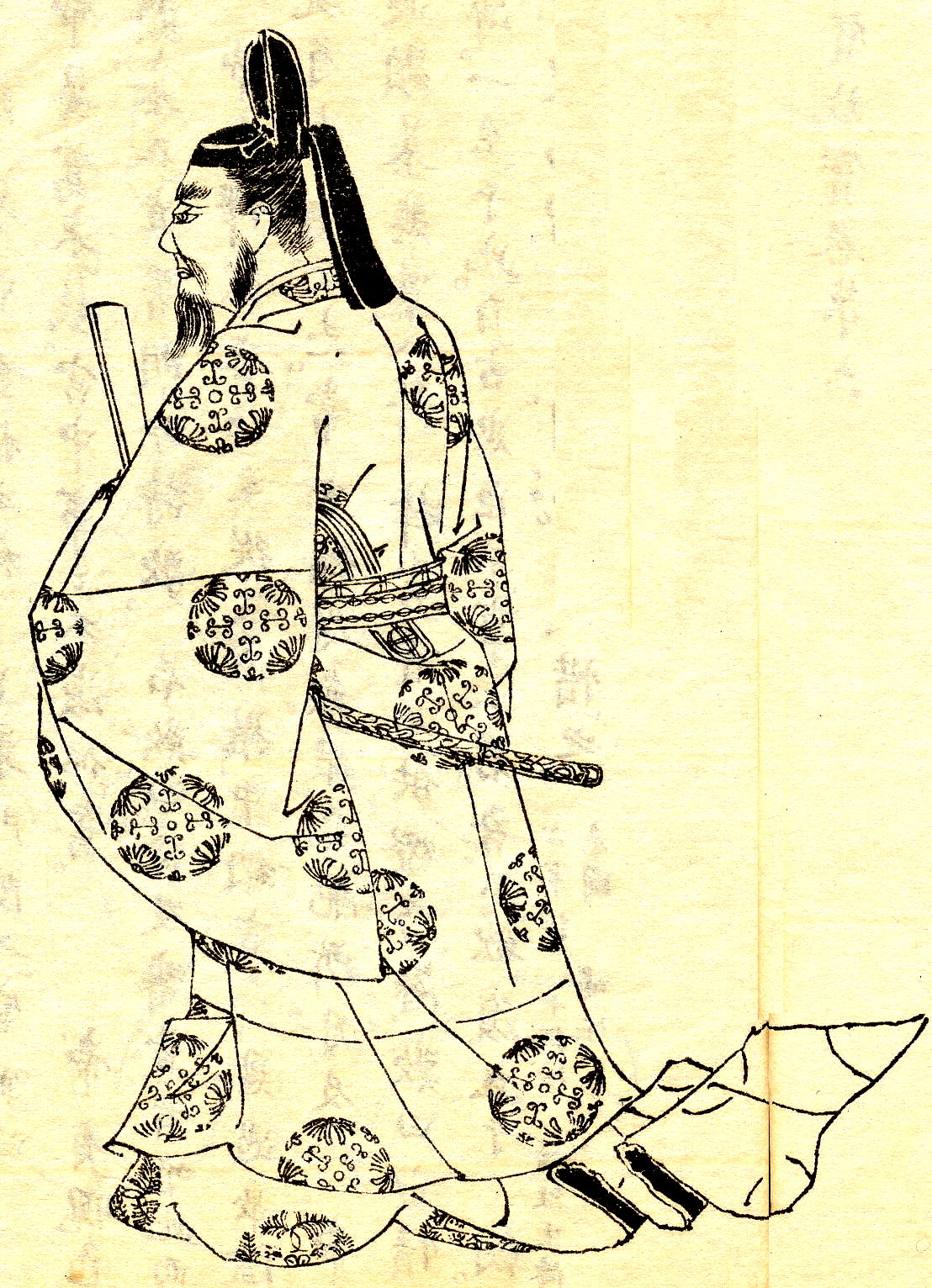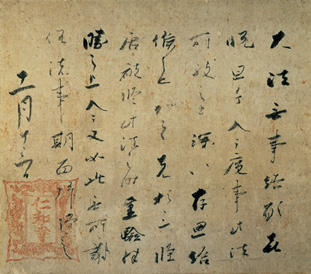|
Ima Kagami
The is a Japanese '' rekishi-monogatari'' (historical tale) written in the late Heian period.''Britannica Kokusai Dai-hyakkajiten'' article "Imakagami". 2007. Britannica Japan Co.'' MyPedia'' article "Imakagami". 2007. Hitachi Systems & Services.''Digital Daijisen'' entry "Imakagami". Shogakukan. It is also called the or the . Date and authorship It has been speculated that the work was compiled in or shortly after 1170; Donald Keene, citing Isao Takehana, stated that the work was probably written between the eighth month of 1174 and the seventh month of 1175.Keene 1999 : 559, citing (566, note 28) Takehana 1984 : 620 (Vol. 3). The author is uncertain, but the most likely candidate is the ''waka'' poet .Keene 1999 : 559, citing (566, note 29) Takehana 1984 : 620-622 (Vol. 3) and Matsumura 1979 : 156-161. Structure and style The text is in ten volumes, and is told from the point of view of an elderly woman who is described as a granddaughter of , the narrator of the '' Ōkagam ... [...More Info...] [...Related Items...] OR: [Wikipedia] [Google] [Baidu] |
Rekishi-monogatari
''Rekishi monogatari'' (歴史物語) is a category of Japanese literature defined as extended prose narrative. Structurally, the name is composed of the Japanese words ''rekishi'' (歴史), meaning history, and ''monogatari'' (物語), meaning tale or narrative. Because of this it is commonly translated as ‘historical tale’. Although now categorised as works of fiction, Japanese readers before the nineteenth century traditionally accepted and read ''rekishi monogatari,'' as well as the related ''gunki monogatari'' and earlier ''Six National Histories'', as literal and chronological historical accounts. History Creation of ''monogatari'' ''Monogatari'' is categorised as Japanese extended prose literature, and is comparable to the epic novel. It first emerged in the late ''Heian period'', which held dominion from 749-1573 C.E. It is believed to have originated from the oral tradition of the court ladies at the time. This is supported through the language used in examples of ' ... [...More Info...] [...Related Items...] OR: [Wikipedia] [Google] [Baidu] |
Minamoto Clan
was one of the surnames bestowed by the Emperors of Japan upon members of the imperial family who were excluded from the line of succession and demoted into the ranks of the nobility from 1192 to 1333. The practice was most prevalent during the Heian period (794–1185 AD), although its last occurrence was during the Sengoku period. The Taira were another such offshoot of the imperial dynasty, making both clans distant relatives. The Minamoto clan is also called the , or less frequently, the , using the on'yomi reading for Minamoto. The Minamoto were one of four great clans that dominated Japanese politics during the Heian period—the other three were the Fujiwara, the Taira, and the Tachibana. History The first emperor to grant the surname Minamoto was Minamoto no Makoto, seventh son of Emperor Saga. The most prominent of the several Minamoto families, the Seiwa Genji, descended from Minamoto no Tsunemoto (897–961), a grandson of Emperor Seiwa. Tsunemoto went to the p ... [...More Info...] [...Related Items...] OR: [Wikipedia] [Google] [Baidu] |
Manju (era)
was a after ''Jian'' and before ''Chōgen.'' This period spanned the years from July 1024 through July 1028. The reigning emperor was . Change of era * 1024 : The new era name was created to mark an event or series of events. The previous era ended and the new one commenced in ''Jian'' 4, on the 13th day of the 7th month of 1024. Events of the ''Manju'' era * 1024 (''Manju 1''): Fujiwara no Kintō withdrew from his public duties; and he retired to Kitayama in the north of Kyoto. * May 4, 1026 (''Manju 3, 15th day of the 4th month''): a partial lunar eclipse. * 1027 (Manju 4): Fujiwara no Michinaga died at age 62.Ackroyd, Joyce. (1982). ''Lessons from History: the Tokushi Yoron,'' p. 29. Notes References * Ackroyd, Joyce. (1982) ''Lessons from History: The Tokushi Yoron.'' Brisbane: University of Queensland Press. OCLC 7574544 * Brown, Delmer M. and Ichirō Ishida, eds. (1979) ''Gukanshō: The Future and the Past.''Berkeley: University of California Press. OCLC 251325323* ... [...More Info...] [...Related Items...] OR: [Wikipedia] [Google] [Baidu] |
Emperor Go-Ichijo
An emperor (from la, imperator, via fro, empereor) is a monarch, and usually the sovereign ruler of an empire or another type of imperial realm. Empress, the female equivalent, may indicate an emperor's wife ( empress consort), mother (empress dowager), or a woman who rules in her own right and name (empress regnant). Emperors are generally recognized to be of the highest monarchic honor and rank, surpassing kings. In Europe, the title of Emperor has been used since the Middle Ages, considered in those times equal or almost equal in dignity to that of Pope due to the latter's position as visible head of the Church and spiritual leader of the Catholic part of Western Europe. The Emperor of Japan is the only currently reigning monarch whose title is translated into English as "Emperor". Both emperors and kings are monarchs or sovereigns, but both emperor and empress are considered the higher monarchical titles. In as much as there is a strict definition of emperor, it is that ... [...More Info...] [...Related Items...] OR: [Wikipedia] [Google] [Baidu] |
Princeton, New Jersey
Princeton is a municipality with a borough form of government in Mercer County, in the U.S. state of New Jersey. It was established on January 1, 2013, through the consolidation of the Borough of Princeton and Princeton Township, both of which are now defunct. Centrally located within the Raritan Valley region, Princeton is a regional commercial hub for the Central New Jersey region and a commuter town in the New York metropolitan area.New York-Newark, NY-NJ-CT-PA Combined Statistical Area . Accessed December 5, 2020. As of the |
Princeton University Press
Princeton University Press is an independent publisher with close connections to Princeton University. Its mission is to disseminate scholarship within academia and society at large. The press was founded by Whitney Darrow, with the financial support of Charles Scribner, as a printing press to serve the Princeton community in 1905. Its distinctive building was constructed in 1911 on William Street in Princeton. Its first book was a new 1912 edition of John Witherspoon's ''Lectures on Moral Philosophy.'' History Princeton University Press was founded in 1905 by a recent Princeton graduate, Whitney Darrow, with financial support from another Princetonian, Charles Scribner II. Darrow and Scribner purchased the equipment and assumed the operations of two already existing local publishers, that of the ''Princeton Alumni Weekly'' and the Princeton Press. The new press printed both local newspapers, university documents, ''The Daily Princetonian'', and later added book publishing to it ... [...More Info...] [...Related Items...] OR: [Wikipedia] [Google] [Baidu] |
Canada
Canada is a country in North America. Its ten provinces and three territories extend from the Atlantic Ocean to the Pacific Ocean and northward into the Arctic Ocean, covering over , making it the world's second-largest country by total area. Its southern and western border with the United States, stretching , is the world's longest binational land border. Canada's capital is Ottawa, and its three largest metropolitan areas are Toronto, Montreal, and Vancouver. Indigenous peoples have continuously inhabited what is now Canada for thousands of years. Beginning in the 16th century, British and French expeditions explored and later settled along the Atlantic coast. As a consequence of various armed conflicts, France ceded nearly all of its colonies in North America in 1763. In 1867, with the union of three British North American colonies through Confederation, Canada was formed as a federal dominion of four provinces. This began an accretion of provinces an ... [...More Info...] [...Related Items...] OR: [Wikipedia] [Google] [Baidu] |
Waterloo, Ontario
Waterloo is a city in the Canadian province of Ontario. It is one of three cities in the Regional Municipality of Waterloo (formerly Waterloo County, Ontario, Waterloo County). Waterloo is situated about west-southwest of Toronto. Due to the close proximity of the city of Kitchener, Ontario, Kitchener to Waterloo, the two together are often referred to as "Kitchener–Waterloo", "K-W" or "The Twin Cities". While several unsuccessful attempts to combine the municipalities of Kitchener and Waterloo have been made, following the 1973 establishment of the Region of Waterloo, less motivation to do so existed, and as a result, Waterloo remains an independent city. At the time of the Canada 2021 Census, 2021 census, the population of Waterloo was 121,436. History Indigenous peoples and settlement According to the city, Indigenous peoples in Canada, indigenous peoples lived in its area, including the Haudenosaunee, Iroquois, Anishinaabe and Neutral Nation. After the end of the Am ... [...More Info...] [...Related Items...] OR: [Wikipedia] [Google] [Baidu] |
Wilfrid Laurier University Press
Wilfrid Laurier University Press, based in Waterloo, Ontario, is a publisher of scholarly writing and is part of Wilfrid Laurier University. The fourth-largest university press in Canada, WLUP publishes work in a variety of disciplines in the humanities and social sciences — literary criticism, indigenous studies, sociology, environmental studies, and history among them — as well as books of regional interest. Laurier Press also provides publishing services to scholarly associations and journals. History The Press was founded in 1974 as a non-profit enterprise. They publish 20-25 titles per year and have 800 physical titles in print and digital formats. WLUP has been typesetting books from electronic files since 1984, and was one of the first publishers to have a web presence in 1994. Wilfrid Laurier University Press distributes titles for the Laurier Centre for Military, Strategic and Disarmament Studies, Toronto International Film Festival (in Canada) and the Cress Board of ... [...More Info...] [...Related Items...] OR: [Wikipedia] [Google] [Baidu] |
Kaō (era)
was a after ''Nin'an'' and before '' Jōan.'' This period spanned the years from April 1169 through April 1171. The reigning emperor was . Change of era * January 30, 1169 : The new era name was created to mark an event or series of events. The previous era ended and a new one commenced in ''Nin'an'' 4, on the 8th day of the 4th month of 1169.Brown, p. 332. Events of the ''Kaō'' era * 1169 (''Kaō 1, 3rd month''): The former-Emperor Go-Shirakawa made a pilgrimage to Mont Koya.Titsingh p. 196./ref> * 1169 (''Kaō 1, 6th month''): Go-Shirakawa accepted tonsure as a Buddhist priest; and he took the title ''Hōō.'' * 1169 (''Kaō 1, 12th month''): The ''chūnagon'' Fujiwara no Nurisika was banished to Bingo province as a consequence of complaints of Buddhist priests from Mt. Hiei; but shortly thereafter, he was recalled to Heian-kyō because of past services to Emperor Go-Shirakawa. References ;Specific ;General * Brown, Delmer M. and Ichirō Ishida, eds. (1979) ''Gukanshō: T ... [...More Info...] [...Related Items...] OR: [Wikipedia] [Google] [Baidu] |
Emperor Takakura
was the 80th emperor of Japan, according to the traditional order of succession. His reign spanned the years from 1168 through 1180. Genealogy Before his ascension to the Chrysanthemum Throne, his personal name (his ''imina'') was Norihito''-shinnō'' (憲仁親王). He was also known as Nobuhito''-shinnō''. Takakura was the fourth son of Emperor Go-Shirakawa, and thus uncle to his predecessor, Emperor Rokujō. His mother was Empress Dowager Taira no Shigeko, the younger sister of Taira no Tokiko, the concubine of Taira no Kiyomori. His empress consort was Taira no Tokuko (later Empress Dowager Kenrei), the regent of Taira no Kiyomori, and thus his first cousin (as his mother and Tokuko's mothers were sisters). * Empress consort: Taira no Tokuko (平徳子) – later Kenreimon-in ** First Son: Imperial Prince Tokihito (言仁親王) – later Emperor Antoku * Lady-in-waiting: Bōmon Shokushi (坊門殖子; 1157–1228) later Shichijō-in (七条院), Bomon Nobutaka's daught ... [...More Info...] [...Related Items...] OR: [Wikipedia] [Google] [Baidu] |



.jpg)
